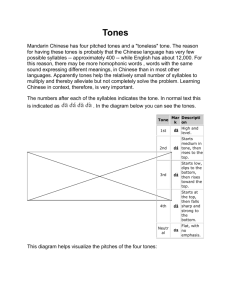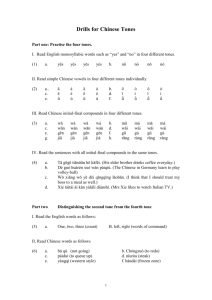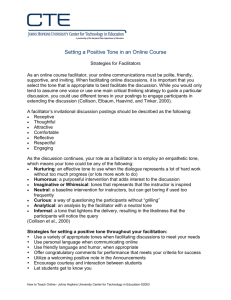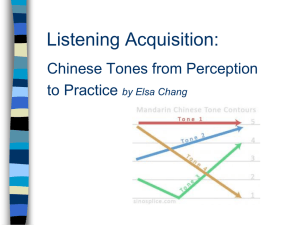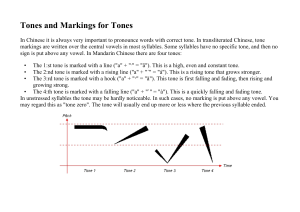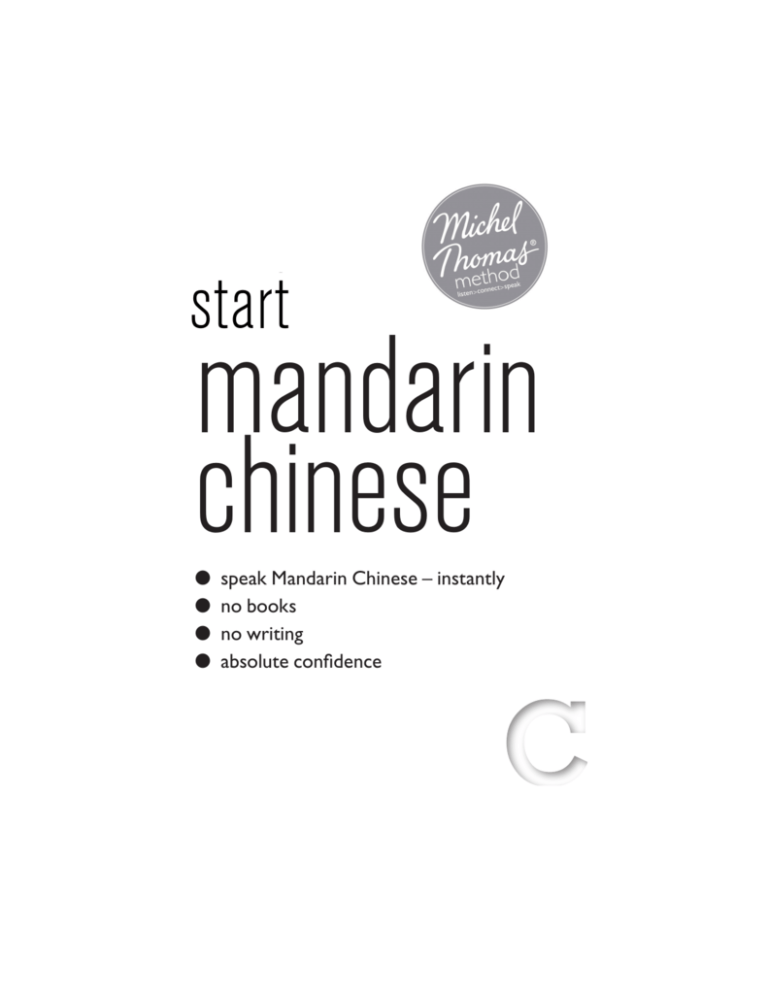
total
start
mandarin
chinese
●
●
●
●
speak Mandarin Chinese – instantly
no books
no writing
absolute confidence
To find out more, please get in touch with us.
For general enquiries and for information on Michel Thomas:
Call: 020 7873 6400 Fax: 020 7873 6325 Email: mtenquiries@hodder.co.uk
To place an order:
Call: 01235 400414 Fax: 01235 400454 Email:
uk.orders@bookpoint.co.ukwww.michelthomas.co.uk
You can write to us at:
Hodder Education, 338 Euston Road, London NW1 3BH
Unauthorized copying of this booklet or the accompanying audio material is
prohibited, and may amount to a criminal offence punishable by a fine and/or
imprisonment.
First published in UK 2007 by Hodder Education, an Hachette UK Company, 338 Euston Road,
London NW1 3BH.
Start Mandarin Chinese Copyright © 2007, 2011, in the methodology, Thomas Keymaster Languages
LLC, all rights reserved; in the content, Harold Goodman.
All rights reserved. No part of this publication may be reproduced or transmitted in any form or by
any means, electronic or mechanical, including photocopy, recording, or any information storage and
retrieval system, without permission in writing from the publisher or under licence from the
Copyright Licensing Agency Limited. Further details of such licences (for reprographic reproduction)
may be obtained from the Copyright Licensing Agency Limited, Saffron House, 6–10 Kirby Street,
London EC1N 8TS, UK.
Typeset by Transet Limited, Coventry, England.
Printed in Great Britain.
Impression 10 9 8 7 6 5 4 3 2 1
Year
2014 2013 2012 2011
ISBN
978 1444 13919 8
Welcome to the Michel
Thomas Method
Congratulations on purchasing the truly remarkable way to
learn a language. With the Michel Thomas Method there’s no
reading, no writing and no homework. Just sit back, absorb,
and soon you’ll be speaking another language with confidence.
The Michel Thomas Method works by breaking a language
down into its component parts and enabling you to
reconstruct the language yourself – to form your own
sentences and to say what you want, when you want. By
learning the language in small steps, you can build it up
yourself to produce ever more complicated sentences.
Perfected over 25 years, the all-audio Michel Thomas Method
has been used by millions of people around the world.
Now it’s your turn.
To get started, simply insert CD 1 and press ‘play’!
2
About Michel Thomas
Michel Thomas (1914–2005) was a gifted linguist who
mastered more than ten languages in his lifetime and became
famous for teaching much of Hollywood’s ‘A’ list how to speak
a foreign language. Film stars such as Woody Allen, Emma
Thompson and Barbra Streisand paid thousands of dollars
each for face-to-face lessons.
Michel, a Polish Jew, developed his method after discovering
the untapped potential of the human mind during his
traumatic wartime experiences. The only way he survived this
period of his life, which included being captured by the
Gestapo, was by concentrating and placing his mind beyond
the physical. Fascinated by this experience, he was determined
that after the war he would devote himself to exploring
further the power of the human mind, and so dedicated his
life to education.
In 1947, he moved to Los Angeles and set up the Michel
Thomas Language Centers, from where he taught languages
for over fifty years in New York, Beverly Hills and London.
Michel Thomas died at his home in New York City on
Saturday 8th January 2005. He was 90 years old.
Start Mandarin Chinese index
Note about transliteration
The Mandarin words are transliterated in this track listing using the
pin-yin method of romanization. In this method the tones are
represented by marks on the vowels that look like the hand
movements that we’re using (see pages 8–9):
- flat tone (green thumb out)
´ rising tone (blue finger up)
v falling and rising tone (red ‘V’ for victory)
` falling tone (black finger down)
CD 1 Track 1
Introduction. How to use this course. Background to Chinese.
CD 1 Track 2
Tones in Chinese languages.
CD 1 Track 3
Flat tone (green thumb out); zhōng ‘middle’
CD 1 Track 4
Rising tone (blue finger up); rén ‘person’
CD 1 Track 5
Falling and rising tone (red ‘V’ for victory); wǒ ‘I, me’
CD 1 Track 6
Falling tone (black finger down); shì ‘to be’
CD 1 Track 7
The form of the verb ‘to be’ in Chinese doesn’t change: shì (‘to be’)
also means ‘am, are, is’; wǒ shì ‘I am’
3
4
CD 1 Track 8
nǐ ‘you’; nǐ shì ‘you are’; the forms of Chinese verbs never change.
No word for ‘a’ or ‘an’: wǒ shì rén ‘I am a person’
CD 1 Track 9
guó ‘kingdom, nation’; zhōng guó ‘middle kingdom’ = China; zhōng
guó rén ‘middle kingdom person’ = Chinese (person)
CD 1 Track 10
tā ‘he, him, she, her, it’; dōu ‘both, all’; hé ‘and’; position of dōu ‘both,
all’ in Mandarin sentences: ‘You and he both are Chinese’, not ‘are
both’, as in English
CD 1 Track 11
měi ‘beautiful’; měi guó ‘America’; měi guó rén ‘American’; yīng
‘brave’; yīng guó ‘England, Britain’; yīng guó rén ‘English’
CD 1 Track 12
men = plural form of individual, single form; wǒmen ‘we, us’; nǐmen
‘you’; tāmen ‘they, them’; kěshì ‘but’
CD 1 Track 13
ma = question marker, to change a statement into a question; shì ‘is’
can be used to mean ‘yes’
CD 1 Track 14
nǐne ‘how about you?’; tāmenne ‘how about them?’
CD 1 Track 15
máng ‘busy’; also means ‘to be busy’
CD 1 Track 16
bù ‘no, not’
CD 1 Tracks 1 and 2
hěn ‘very’, also fulfils the two-syllable meter rule: a dummy word to go
with an adjective; bù máng ‘not busy’
CD 1 Tracks 3 and 4
nǐ hǎo ‘hello’; hǎo ‘good, to be good, do well’; nǐ hǎo ma ‘you good?
you doing well?’ = ‘how are you?’
CD 2 Track 5
In Chinese the character/word has the same form for both individual
and plural form; word order determines meaning
CD 2 Track 6
yě ‘also, too’; bù hěn hǎo ‘not very good, well’
CD 2 Track 7
bú shì ‘not is’ (‘trampoline’ rule)
CD 2 Track 8
A question with a question word, such as wèi shénme ‘why’. All
Chinese languages use the same characters to mean the same thing,
but their pronunciation differs.
CD 2 Track 9
kàn ‘to look, see’; shū ‘book’; kàn shū ‘to read book’; saying ‘yes’ by
repeating verb
CD 2 Track 10
xiàn zài ‘now’; zài ‘at’ emphasizes ‘at this very moment’
CD 2 Track 11
Word order in Chinese: who–when–what is happening
5
6
CD 2 Track 12
xiǎng ‘would like to’
CD 2 Track 13
jiàn ‘to get together, see somebody, meet’; bù xiǎng ‘would not like to’
CD 2 Track 14
tài ‘too’; néng ‘can’; bù néng ‘cannot’; tai … bù néng ‘too … no can’ =
‘too … to’
8
Learning the tones using hand movements
Mandarin has four tones, plus a neutral non-tone, which are critical
for communication. While there is considerable leeway for differences
in pronunciation (many Chinese learn Mandarin as a second
language) there is very little for tones. If your tone is off you won’t be
understood. Tones, when made user-friendly, are actually quite
simple to grasp and integrate into your learning.
The method for learning the tones* which you will experience in this
course is specifically designed to address all styles of language
learning. It will permit your central nervous system to permanently
create pathways that reflect your personal learning style (visual,
kinaesthetic, auditory, etc.) and support you in effortless recall and
usage of the correct tone at the proper moment in your
communication. It works on a subconscious level. You will very
quickly find that you are using the movements as a natural part of
your learning. These movements work. They have been tested and
refined on students without any previous knowledge of Mandarin from
many different backgrounds and age levels (teens to the elderly).
I encourage you to allow your hands to move with the movements.
For some of you that will be essential. For others, this will be less
essential. Trust whatever helps you. It will work for you as you permit
it to do so.
In this method of teaching tones, each movement is linked to a tone
and colour. Romanized Mandarin (pin-yin) is written with four distinct
tones, which are shown with marks over the affected vowel. These
marks are shown in brackets below. The tones are generally listed in
the following order when taught and when words are listed in a
dictionary.
*patent pending
First tone: ( ¯ ) long, steady tone.
Colour: Green.
Movement: Thumb out to side with
closed fist.
Example: zhōng (‘middle’).
Second tone: ( ´ ) rising tone.
Colour: Blue.
Movement: Index finger pointing up.
Example: rén (‘person’).
Third tone: ( ˇ ) falling–rising tone. This tone
actually resembles a tick mark (UK) or check
mark (US) (✓). It starts rather low, goes
down a bit and then rises up to the level of
the green tone.
Please pay close attention to the Chinese
native speaker’s demonstration of this tone.
Colour: Red.
Movement: Closed fist with index and
middle fingers forming a V and pointing up.
Example: wǒ (‘I, me’).
Fourth tone: ( ` ) falling tone. Colour: Black.
Movement: Index finger pointing down.
Example: shì (‘to be, am, is, are’).
Neutral non-tone: toneless.
Colour: None.
Movement: Closed fist.
Example: ma (question marker).
9
Millions of people
worldwide speak a
new language thanks
to the Michel Thomas
Method.
Here’s what people say about Michel Thomas:
“This guy is one of my heroes.”
“What a legend. I love his method.”
“Definitely the best way to learn.”
“Just after a couple of days I’m confident that I will be able to
speak directly.”
“It’s the best way to learn a foreign language.”
“Totally life changing.”
“The Michel Thomas course is much the easiest to make progress with.”
“He’s the best.”
“A truly inspirational way to learn a language.”
“With Michel you learn a language effortlessly.”
‘‘The nearest thing to
painless learning.’’
The Times

